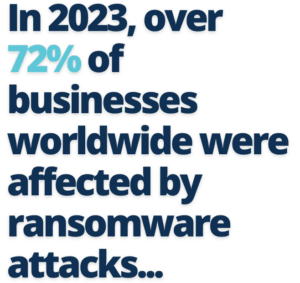
How to Outsmart Ransomware Attacks
Think it can't happen to you? Think again.

How to Outsmart Ransomware Attacks
Think it can't happen to you? Think again.
Ransomware attacks have become a major threat to individuals, businesses, and even government agencies worldwide. These malicious attacks can lock you out of your data and demand hefty ransoms for its return, causing significant financial and operational damage. Understanding how to protect yourself from these threats is crucial. In this blog post, we'll explore what ransomware is, how it works, and most importantly, how to avoid becoming a victim.

Understanding Ransomware
What is Ransomware?
Ransomware is malware that encrypts a victim's files, making them inaccessible until a ransom is paid. Attackers often demand payment in cryptocurrencies like Bitcoin to remain anonymous. There are various types of ransomware, including:
- Crypto Ransomware: Encrypts files, rendering them unusable without the decryption key.
- Locker Ransomware: Locks the user out of the entire system.
- Scareware: Fake software that claims to detect issues and demands money to fix them.
- Doxware: Threatens the release of sensitive data unless a ransom is paid.
How Does Ransomware Spread?
Ransomware can infiltrate your system through various means, including:
- Phishing Emails: Malicious attachments or links in emails.
- Malvertising: Online ads that spread malware.
- Drive-By Downloads: Infected websites that automatically download malware.
- Remote Desktop Protocol (RDP) Vulnerabilities: Exploiting weak passwords or outdated software.
Eight tips for avoiding Ransomware attacks
1: Educate yourself and your team
Knowledge is your first line of defense. Understanding how ransomware works and recognizing the signs of an attack can prevent many incidents.
- Training: Conduct regular cybersecurity training sessions.
- Awareness: Encourage employees to be cautious with email attachments and links.
- Updates: Stay informed about the latest ransomware threats and tactics.
2. Use Strong Passwords and Multi-Factor Authentication
Strong, unique passwords are vital for protecting your accounts and systems.
- Password Management: Use a password manager to generate and store complex passwords.
- Multi-Factor Authentication (MFA): Implement MFA for an additional layer of security.
3. Keep Your Software Updated
Outdated software is a common target for ransomware attacks.
- Automatic Updates: Enable automatic updates for your operating system and applications.
- Patch Management: Regularly apply security patches to fix vulnerabilities.
4. Back Up Your Data Regularly
Regular backups can save you from paying a ransom if your data is encrypted.
- Backup Strategy: Implement a 3-2-1 backup strategy: three copies of your data, on two different media, with one offsite.
- Testing: Regularly test your backups to ensure they can be restored.
5. Implement Advanced Security Solutions
Invest in robust security solutions to protect your network and data.
- Antivirus Software: Use reputable antivirus software and keep it updated.
- Firewall: Implement a strong firewall to block unauthorized access.
- Intrusion Detection Systems (IDS): Use IDS to monitor and respond to suspicious activity.
6. Restrict Administrative Privileges
Limit access to critical systems and data to reduce the risk of an attack.
- Least Privilege Principle: Only grant access necessary for users to perform their jobs.
- Segmentation: Segment your network to contain potential breaches.
7. Secure Remote Access
With the rise of remote work, securing remote access has become crucial.
- VPN: Use a Virtual Private Network (VPN) for secure remote connections.
- RDP Security: Secure RDP with strong passwords and two-factor authentication, and disable it if not needed.
8. Monitor and Respond to Threats
Proactively monitoring your systems can help you detect and respond to threats quickly.
- Security Information and Event Management (SIEM): Use SIEM to aggregate and analyze security data.
- Incident Response Plan: Develop and regularly update an incident response plan.
Responding to a Ransomware Attack
Despite taking all precautions, you might still fall victim to a ransomware attack. Here’s how to respond:
- Isolate the Infection: Immediately disconnect infected systems from the network to prevent the spread.
- Identify the Ransomware: Determine the type of ransomware to understand the potential damage and recovery options.
- Report the Attack: Notify relevant authorities and report the incident to cybersecurity organizations.
- Restore from Backup: If you have secure backups, restore your system to avoid paying the ransom.
- Engage Professionals: Consider hiring cybersecurity experts to handle the incident and strengthen your defenses.
Conclusion
Ransomware attacks can be devastating, but with the right strategies, you can significantly reduce your risk. Education, strong passwords, regular updates, data backups, advanced security solutions, restricted access, secure remote connections, and proactive monitoring are all crucial components of a robust cybersecurity strategy. By implementing these measures, you can protect your data and systems from ransomware and other cyber threats.
Remember, the best defense is a proactive one. Stay informed, stay vigilant, and stay secure.
Ready to Learn More About Advanced Security Solutions?
Schedule a call with one of our cybersecurity experts today.


